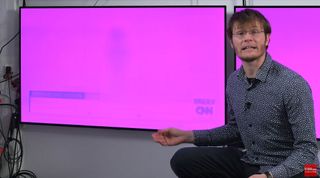One year later, this ongoing burn-in test shines light on OLED displays
Several OLED TVs have been undergoing a burn-in test for the past year.
If what was displayed at the Consumer Electronics Show is any indication, we are likely to see at least a handful of OLED monitors emerge in the marketplace this year—Dell, for example, showed of a prototype 55-inch Alienware OLED display for gamers. OLED displays typically look better than LCD, and sometimes much better, though the technology also suffers from burn-in. Should you really be concerned? An ongoing test of several OLED displays has reached the one-year mark, and the results are *ahem* illuminating.
The folks at Rtings.com, a well-known review site that routinely posts in-depth reviews of televisions and monitors (and headphones), has been running two tests on nine TVs for the past year. The tests were designed to gauge how much of a problem burn-in really is, and to answer common questions people have raised.
In the first test, Rtings compares three different display types—OLED, IPS (LCD), and VA (LCD). The second test consists of six OLED TVs, with the goal being "to determine how content and brightness affect the risk of burn-in."
For the second test, Rtings turns on the TVs for 20 hours per day, in 5-hour blocks at a time to simulate typical real-world usage. This is all automated through a micro-controller that sends infrared signals to the TVs, just like a remote control. Rtings also activated any available burn-in prevention features.
Having done this for the past year, Rtings came to a few conclusions. One is that people who watch varied content shouldn't have any trouble with burn-in. The OLED displays have also maintained their brightness levels, which is great, whereas the IPS and VA displays have not.

Unfortunately, burn-in is a real problem in some cases. This is particularly true when viewing static content with bright colors. A CNN feed was one of the worst offenders. You can see in the photo above that CNN's logo and ticker are permanently emblazoned on the TV.
What about gaming? We wish Rtings had taken a more in-depth look at how playing games can affect burn-in. That said, the site did incorporate Call of Duty: WWII into its testing. Rtings had anticipated this leading to some burn-in because of the heads up display (HUD), but instead it saw a "great result," most likely because it doesn't use saturated colors.
The biggest gaming news, reviews and hardware deals
Keep up to date with the most important stories and the best deals, as picked by the PC Gamer team.
Rtings also incorporated FIFA 18 into its tests. While Call of Duty didn't result in any noticeable burn-in, FIFA 18 did, after around 800 hours of usage. However, the burned in areas are not noticeable when viewing normal content.
So, what's the takeaway?
"Our current stance is that if you vary your content and don’t display static areas then you’re unlikely to experience any issues. If you do plan to watch a lot of static content with bright, saturated colors, then an OLED TV probably isn’t for you," Rtings says.
That said, there's only so much that can be gleaned from these tests, as it pertains to gaming. It'd be nice if a wider selection of games were being tested. It's also worth noting that newer displays might handle burn-in better than these year-old TVs. That should hold true for any OLED monitors that emerge this year as well.
Paul has been playing PC games and raking his knuckles on computer hardware since the Commodore 64. He does not have any tattoos, but thinks it would be cool to get one that reads LOAD"*",8,1. In his off time, he rides motorcycles and wrestles alligators (only one of those is true).
Most Popular






